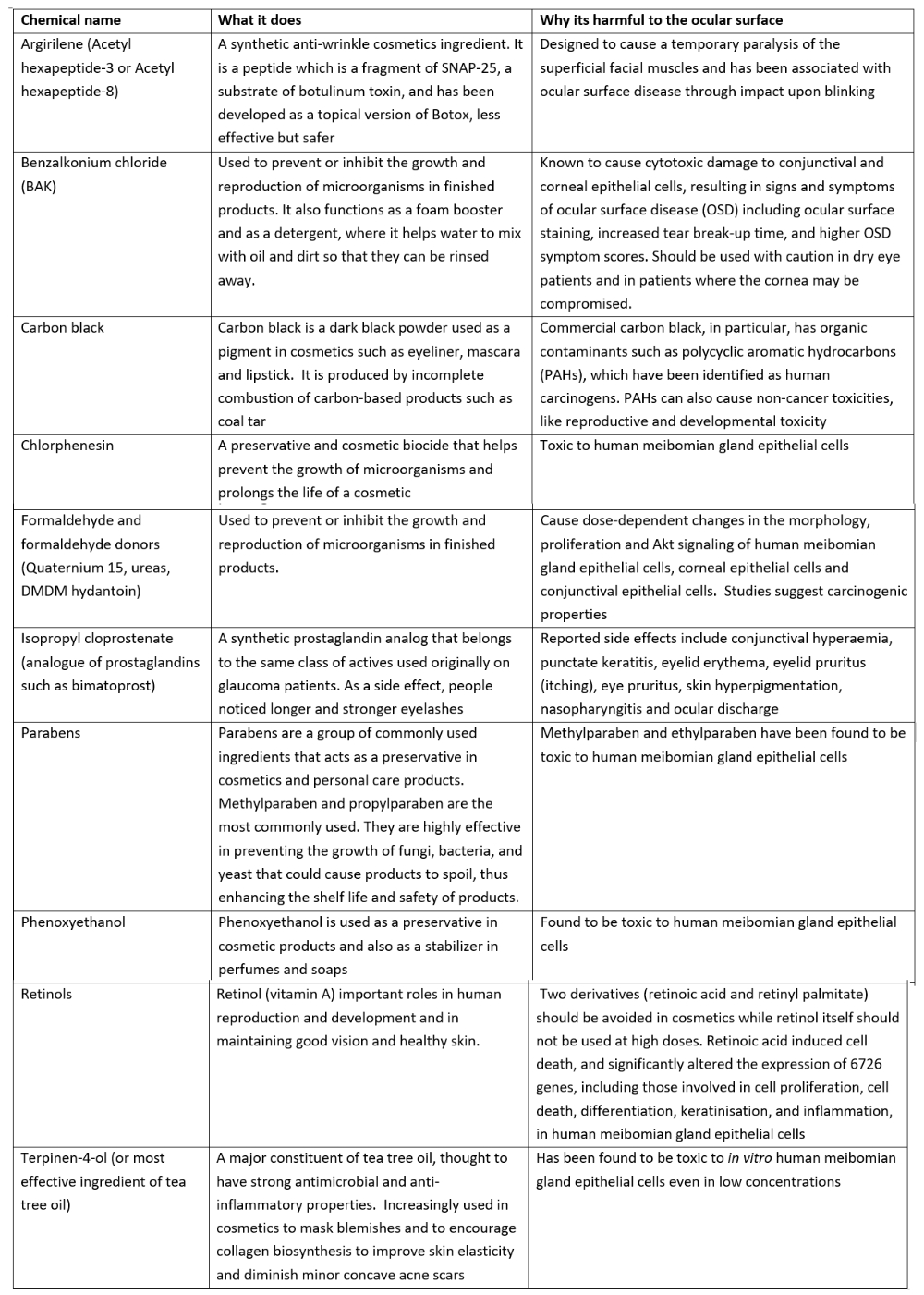There is an increasing body of evidence suggesting that many of the components of the cosmetic products routinely applied to the periocular skin and lid margins may have a negative impact on the tears and ocular surface and, in some cases, have been linked with more serious disease. In a recent CPD article (Optician 30.09.22), therapeutic optometrist Sarah Farrant explained how her experience, both with patients attending a dedicated dry eye clinic and in more general contact lens practice, supported this view and offered a review of some of the evidence so far published along with a table of some cosmetic ingredients and their harmful effects (table 1).
One recent study, for example, has highlighted that the prevalence of dry eye disease among women who used eye cosmetics was over 70%,1 much higher than the 5 to 50% among the general population.2 In addition, approximately 25% of participants using eye make-up rarely removed it before sleep. This was shown to be a further significant risk factor in the severity of dry eye.
The argument for the significance of cosmetic impact has been supported by a series of illustrative case studies. The original article, plus the two case study features, are now the source material for a new interactive exercise. Once you have read them, consider the details of the following case and then address the questions relating to it in your discussions.
Case scenario for discussion
A 22-year-old female attends your practice as she would like to try contact lenses for full time wear. Since starting work in an office, where she is required to use a desktop computer throughout the day, she has found that she increasingly relies on her spectacles as the clarity they give makes work easier. However, she hates wearing them because she ‘hates the way I look in glasses.’
Her refraction is:
•R: -1.25 / -1.00 x 170 (6/4 / N4.5)
•L: -1.00 / -1.25 x 180 (6/4 / N4.5)
Figure 1 shows an overview of her right eye, the left is similar; Right eye. (a) Low magnification. (b) Upper lid. (c) Lower lid. (d) Lower palpebral conjunctiva:

Her general health is good, though she does smoke ‘socially’. When asked about allergies, she confirms she does occasionally suffer from hay fever (last episode some six months ago) for which she ‘takes a tablet from the chemist’.
Also, on occasion, she has had soreness around her eyes with some types of make-up. ‘I now always make sure I use a hypoallergenic brand, because there is no way I am going to stop wearing make-up,’ she states.
Table 1: Ten cosmetic ingredients known to cause damage to the ocular surface and adnexa (fully referenced table available in original article3)

Discuss the following points:
- Would you go ahead with fitting contact lenses and, if so, what would be your first choice to fit (material, design and wear modality)?
- What factors can you identify which might influence future success with contact lens wear?
- Would you mention her cosmetic use if not prompted by the patient – yes or no?
- How would you respond to the patient when she asks: ‘It will be OK to carry on wearing make-up, won’t it?’
Interactive CPD Instructions
In order to be able to log one provider-led interactive CPD point to your MyCPD account, you need to:
- Make sure you have read the article ‘The impact of cosmetics on the ocular surface’.
- Arrange a time to undertake a discussion on the subject with a similarly qualified registrant; another optometrist or dispensing optician.
- Read the case scenario and questions (above) and use them as the basis for the discussion with your colleague. Note, the discussion needs to address each of the questions outlined above and must be for longer than ten minutes
- When finished, you then need to send an email to ‘opticiancpd@markallengroup.com’ as follows;
- Subject box should state ‘Cosmetics – Interactive’
- Please state your name and GOC number
- Please state the name and GOC number of the person you discussed the matter with
- Please confirm you had read the source material
- Please include a summary of your discussion, explaining your views and thoughts on each of the three discussion questions
- Each submission will be read individually and, where needed, feedback will be given directly. Where the submission meets a required standard, you will receive an email confirming this that you can then use as evidence of completion allowing you to log one distance learning interactive CPD point.
- A summary of the responses and discussions will appear in a future issue of Optician with comment from the authors.
- Sarah Farrant is a therapeutic optometrist with a specialist interest in dry eye disease and myopia management practising in Somerset, UK.
References
- Albdaya NA et al. Prevalence of dry eye disease and its association with the frequent usage of eye cosmetics among women. Cureus, 2022;14(7):e27142.
- Gomes JAP et al. TFOS DEWS II: Iatrogenic report. The Ocular Surface, 2017, Volume 15, Issue 3, pps 511-538
- Farrant S. The impact of cosmetics on the ocular surface. Optician, 30.09.2022, pp23-29w
